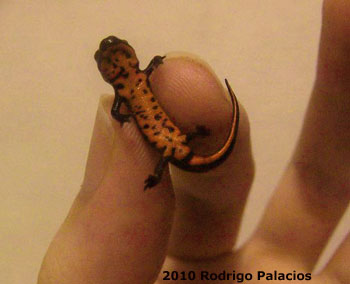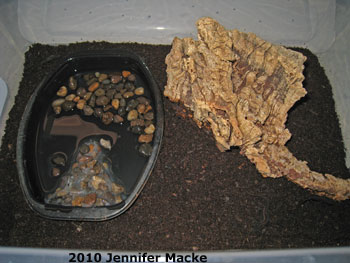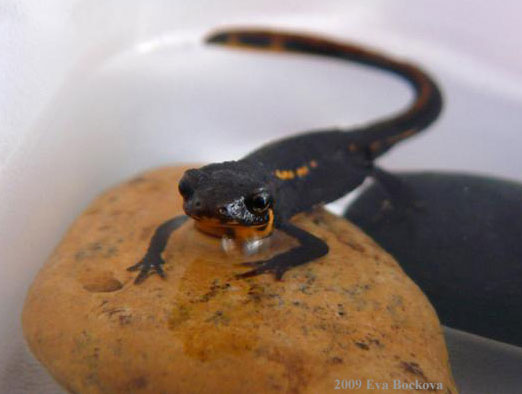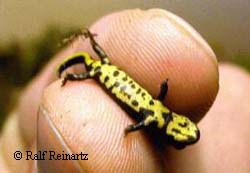Raising Juvenile Cynops orientalis
By Rodrigo Palacios
While this article was written about Cynops orientalis, the advice is generally true for a wide variety of newts that go through a terrestrial juvenile phase.

Cynops orientalis metamorphose at a very small size.
Raising the larvae is easy enough, but then metamorphosis comes, and all of a sudden this species becomes tricky. There are two main reasons why this species can be a bit difficult to raise when compared to other species. First, their size. They usually morph at tiny sizes, normally 3-3.5 cm (1.2-1.5 in) long, but they can be as small as 2 cm (1 in) long. This means they are rather delicate and will need very small prey items to feed on. Secondly, they are not very agile. Small juveniles, especially recently morphed ones, are not good hunters, sometimes being downright clumsy and inefficient.
In order to succeed with this species, an important point is to try and get the larvae to grow as big as possible before morphing. Size can be reduced significantly during metamorphosis, so the bigger the larvae, the better chance of a decently sized juvenile. This will make raising the small morphs much easier.
There are several methods that have proved to be successful in raising this species. They can be divided between terrestrial set-ups and semi-aquatic set-ups.
 A naturalistic terrarium for juvenile newts. |
 A simple terrarium for juvenile newts. |
Terrestrial
Morphs and juveniles are often VERY hydrophobic, which means that many breeders choose to raise them completely terrestrial. This method avoids the risk of drowning. Some people prefer to keep them in spacious, naturalistic tanks. The goal of such a tank is usually to provide a natural environment in which the tiny prey (usually springtails and isopods) will breed freely, providing food for the juveniles. This kind of set-up has the advantage of being almost self-maintaining and requiring very little attention. However, it makes keeping control of the juveniles very hard, so if problems arise with a given individual, you may miss it entirely and lose the animal. Additionally, when using soil, problems may occur if it gets ingested accidentally. Moss cover or leaf-litter usually helps prevent that.
In order to maintain close control of how the juveniles are doing, some breeders choose to raise them terrestrially on paper kitchen towels. This method allows the keeper to monitor each individual, and also guarantees the prey will remain clean and readily available. Prey can be thrown in so that each animal hunts as it pleases, or the animals can be hand-fed with tweezers, for even further control of each individual. Although sometimes tricky, after a while most juveniles take to hand-feeding very well. Care should be taken in keeping the paper substrate clean by changing it when it becomes soiled. Kitchen paper towels and hand-feeding are certainly more labourious than allowing the juveniles to hunt freely in a more complex, naturalistic set-up.
For in-depth information about options for terrestrial substrates, see Terrestrial Substrates.
Semi-aquatic

A Cynops pyrrhogaster juvenile
being raised in a shallow semi-aquatic setup.
Despite being initially hydrophobic, juveniles can be "trained" to live semi-aquatically. Older juveniles might be more accepting of this method than freshly morphed ones. However even freshly morphed juveniles can adapt well to it. It's important to realise that the suitability of this method will vary depending on individuals, and very likely on geograpical origin of the animals. Some juveniles accept the semi-aquatic life without a problem, but others seem to be strictly terrestrial and might drown if forced to be aquatic. You may find that your animals don't adapt to this method, while other people's do. It may well be a direct consequence of the different geographical adaptations a given species can have (i.e., some populations are more aquatic). It may also be a consequence of size at metamorphosis; larger metamorphs may be more willing to remain semi-aquatic. It is necessary to closely monitor how the juveniles react to avoid problems.
When raising juveniles semi-aquatically, the norm is to start by providing a rather small tank with shallow water (2-3 cm; 1-1.5 in), and easily accessible land areas. The land areas can be arranged by using different materials, and depend on personal preference. Some people use gravel slopes (be very careful with these), others simply tilt the tank, or use bark, wood, and/or stones to create areas emerging from the water. Some choose more elaborate options or use glass dividers. The abundant use of aquatic plants even in such shallow waters is recommended since it helps the juveniles feel comfortable in the water and reach the surface without problems. Don't underestimate the importance of plants, they really do make a difference.
Food
As already mentioned, morphs of this species are tiny and clumsy, so that small, slower prey are necessary initially. For the first days/weeks only livefoods are likely to be accepted. It's common enough for newly morphed juveniles to refuse food for several days, until the metamorphosis is complete. The types of food used vary depending on the different housing methods.
- Terrestrial foods: springtails, woodlice (isopods), whiteworms, fruitflies, waxworms, weevils, pinhead crickets, small slugs, small earthworms, etc.
- Aquatic foods: Daphnia (water fleas), Gammarus (scuds), whiteworms, blackworms, Tubifex, small earthworms, frozen foods, etc.
One can also train terrestrial juveniles to accept dead foods from a piece of paper towel, although some individuals get used to it better than others. So while some feast, others may be left hungry.
For those who want to monitor each individual most closely, the best option is hand-feeding. For large quantities of juveniles, however, this is very time consuming. One consideration with hand-feeding is that it can take some time to work, and until it does it's very important not to insist too much. Repeated attempts to get a stubborn juvenile to eat will only cause stress and prolong the starvation. Try once or twice a day at most, and if the animal shows no interest at all, stop trying. You will know when an animal is interested because it will face the tweezers directly and possibly follow them.
Ideally, juveniles should be fed daily until they reach about 4 cm (2 in) long, when you can begin to feed them every other day or so.
Color

A Cynops orientalis juvenile that has been raised on whiteworms, which lack carotene.
Cynops orientalis is famous for its striking red or orange belly. However, this color is not produced by the newt, but comes entirely from their diet. The pigments responsible for this rich color are carotenes, and among them, two of the primary ones are canthaxanthin and astaxanthin. Carotenoids cannot be produced by any newt. Although many of the other pigments that give caudates their beautiful colors are synthesized by the animal's metabolism, carotenes have to be introduced in the body from an external source. This means that if a captive newt does not receive a carotene rich diet, the color will simply not appear. The result is a cream/yellow color caused by other pigments (flavonoids and such).
Although a lack of orange belly color is no cause for any concern (since the animals health is not affected), some people consider the red belly of the species to be an integral part of it and want their captive-bred animals to display it.
For this you need a carotene rich diet. This can be achieved by means of providing foods that are naturally rich in carotenes. Crustaceans, especially gammarids (but also Daphnia, isopods, anostraceans, and shrimp) are the main source of carotene for aquatic caudates. Although other prey items, like insects and blackworms, also contain carotenes, the concentrations are variable. A general misconception is that bloodworms are excellent for belly color, but they are not. The intense red of this insect comes from haemoglobin (which has no effect on a caudate's coloration). They do contain carotenes, but the concentration is not as high as crustaceans. This is also true when one tries to introduce carotenes into the diet by means of gut-loading the prey with natural source of carotenes, such as plants or spirulina. The concentrations achieved this way are seldom enough to create more than a pale orange belly. It is, however, enough to maintain the strength of the color over time in an animal that already has a deep red belly.

Many commercial vitamin supplements for reptiles contain beta-carotene or other color enhancers.
The use of artificial supplements is the other way to achieve the desired color. Some commercial brands of multivitamin/calcium powders contain beta-carotenes: check the label. Used as any other powdered supplement, the effects are very good. The red pigmentation can be developed quickly. Care should be taken with these commercial powders, as with any other supplement, since overdosing is dangerous. There's the added problem of what compound is used as a source of carotenes. Vitamin A, which was used frequently, can cause severe toxicity and organ damage. These days, safer sources are being used, and it's common that they include canthaxanthin and apocarotinal, which pose little to no danger (as far as i know) of overdosing. Be very careful when using supplements in general, and supplements with carotenes in particular, because, again, overdosing is dangerous. Note: some people use supplements with aquatic animals by diluting a safe amount into the water. My personal experience with this, however, is that it has no effect on coloration.
An important point when trying to make captive-bred C. orientalis display a deep red coloration is when to start providing the necessary carotenes. For the best results, the animal needs to ingest a high concentration of carotenes during the early stages of metamorphosis. Right when the larva is starting to develop the belly pattern is when the effect is more accentuated. After metamorphosis is completed, a longer exposure to carotenes is needed to achieve the same effect, and this increases with age. However, even adults can be "turned red". It will just take a lot longer, since carotenes will accumulate to a lesser degree.
Common problems
- Starvation: Some juveniles simply refuse to eat. This can happen for just a few days after morphing, as has already been mentioned, or it can continue for an extended period of time resulting in the death of the animal. It's important to remember that out of the hundreds of eggs that a single female may produce, obviously not all of them were meant to survive. Some are too small or too weak to survive. It's tough, but it's nature. Starving newts may be enticed with tiny earthworms, waxworms or whiteworms, but there's no guarantee it will work.
- Sudden death: As mentioned above, some are just not fit to survive. Spontaneous deaths are rare but may occur.
- Different growth rates: Whether it's the genetics of each individual or some other factor, it is very common to experience a significant difference in growth rates when raising a group of these juveniles. Some grow fast and have a healthy appetite, sometimes reaching sexual maturity in about a year. Others grow painfully slow (sometimes even certain individuals that appear to eat very well) and may take up to three years to achieve maturity. When the differences of size and attitude become sufficiently apparent, it's recommended to separate the juveniles by size. This will avoid the possible competition between the fittest and the less fit. This is of particular importance if one allows the juveniles to hunt freely.
- Skin infections: It's not common, but if conditions are inadequate, weaker juveniles may develop skin infections FAST. Make sure to provide good ventilation, adequate hygiene, and proper levels of humidity (for terrestrial ones).
- Drowning: It is a possibility. Make absolutely sure that land areas are extrememly easy to access. Remember, plants on the water areas are of great help. Even so, the odd one might drown (although it's quite rare). Never force juveniles or sub-adults to be fully aquatic.
Related Resources
Food Items for Captive Caudates
© 2010 Rodrigo Palacios
